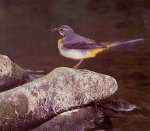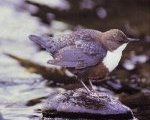 |
 |
 |
 |
 |
 |
 |
 |
 |
 |
 |
 |
 |
 |
Frome Valley Wildlife
The Frome Valley is an important place for wildlife because it provides a green corridor of freshwater habitats, woodlands, parks and open spaces cutting through the densely built up areas in Bristol and the towns and farmlands of South Gloucestershire. The valley allows people to experience a wide range of animals, birds and plants on their doorsteps, some of which are rarely seen so close to the City. Some notable River Frome species are highlighted below:
 Native Crayfish
Recent surveys along the River Frome and its tributaries have found populations of the nationally rare and native white-clawed crayfish. This large crustacean has suffered a massive decline due to the introduction of the American signal crayfish, which carries crayfish plague. Crayfish like clear, well oxygenated water and locations without too much fine sediment. The populations on the Frome are regionally important.

Kingfisher
If youíre lucky you may catch a glimpse of this spectacular bird close to the woodland edges of the River Frome. It is estimated that perhaps only 10 pairs are nesting in the Bristol area and many of these could be in the Frome Valley. The overhanging branches and riverside trees typical along the river, especially between Eastville and Winterbourne are its ideal habitat.
 Grey Wagtail
It is quite common to see this small colourful bird flitting between rocks in the river. The frequent weirs and high water quality ensure that there are several pairs breeding annually in the Frome Valley. The Grey Wagtail is an uncommon breeding species in the region largely because of the limited number of suitable breeding sites. This makes the Frome wagtails an all-important local population.
 Dipper
You might spot this dumpy, medium sized bird hopping on rocks in the river especially where the water is flowing quite fast. Records of Dippers in the Frome Valley go back in history over a hundred years although now it is likely that only a couple of pairs breed regularly. The dipper is a valuable addition to the birdlife of the Frome because it is an indicator of high water quality and it is scarce in many other areas locally.
 House Martin
A significant colony breeds in Colston School, Stapleton close to the top of the western side of the valley. The Frome is important to the continued success of the colony because the birds use the river mud to build their nests and find an abundant variety of insects for food near to the water. These birds have also been seen near to Snuff Mills a little further up the valley.

Bats
The Frome Valley with its combination of lakes, pools, the River Frome itself, broadleaved woodlands and parkland is a haven for several bat species. Three species are frequently observed.
The most common bats on the Frome are Pipistrelles, hunting for their favoured prey, small flies and moths, over ponds and in and amongst broadleaved trees Ė they can eat up to 3,000 midges in a single night! In the summer Pipistrelles will roost in trees and in the roofs of houses. Winter hibernation sites are almost exclusively in buildings.
Daubentonís bats are most likely to be seen flying low over the water in Eastville Park, trawling for mayflies as they emerge from the surface of the water. In summer Daubentonís bats roost in a wide variety of sites including trees, tunnels, bridges and stone buildings. During the winter they hibernate in caves and other underground sites.
Noctules, amongst Britainís largest bats with a wing-span of 45cm, can often be seen flying high over Eastville and Oldbury Parks enroute to their feeding areas - broadleaved woodland, parkland, permanent pasture and water. They feed principally on flies, moths, cockchafer and dor beetles. Hollows in trees provide summer roosts and during the winter they will squeeze into rock fissures and hollows and even bat boxes!
|
|